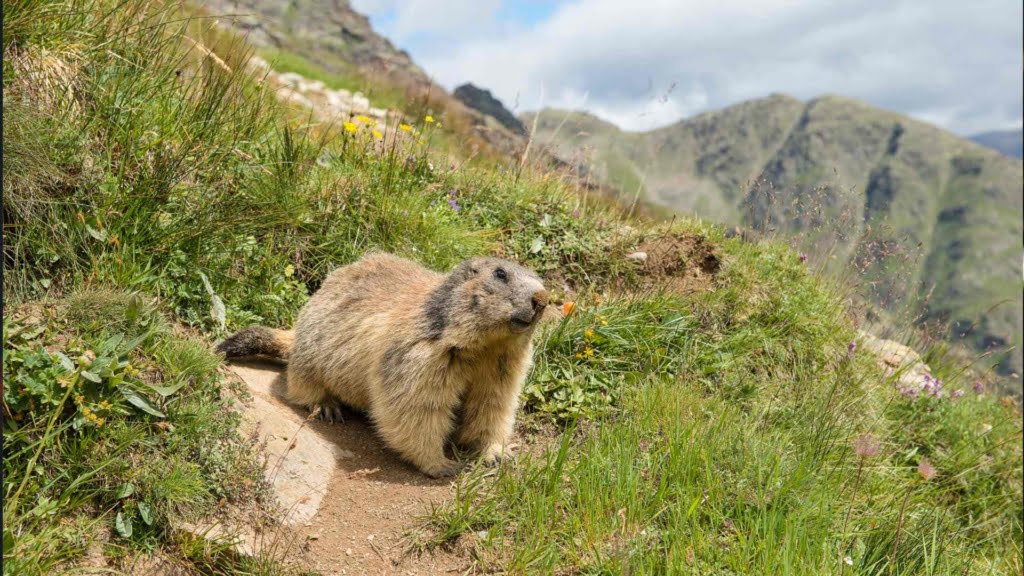Key Takeaways
| Fact | Description |
| Scientific Name | Marmota baibacina |
| Family | Sciuridae (Squirrel family) |
| Common names | Gray Marmot, Altai Marmot |
| Habitat | Mountainous grasslands and shrublands of Central Asia |
| Size | Between 60 to 80 cm from head to tail. Their tails alone measuring between 13 to 15 cm. |
| Weight | Usually weighing between 4 to 6.5 kg. Some of them can even get close to 8 kg. |
| Diet | Sage bush in the spring, and grasses and flowering plants in the summer and fall. |
Introduction
The Gray Marmot, also known as the Altai Marmot, is a fascinating creature that calls the high alpine areas of Central Asia its home. This rodent, belonging to the squirrel family Sciuridae, is one of the larger marmots in the genus Marmota.
Physical Characteristics
Gray Marmots are some of the biggest creatures in the Palearctic region, usually weighing between 4 to 6.5 kg. Some of them can even get close to 8 kg right before they go into hibernation. How big they are can change depending on the time of year (like before or after they hibernate), and also where they live, like how high up they are or how far north or south they are.
Here are some key physical characteristics:
- They are short and stocky with brawny limbs and short tails.
- Their length measuring between 60 to 80 cm from head to tail. Their tails alone measuring between 13 to 15 cm.
- Their forefeet have four digits and strong claws for digging, while their hindfeet have five digits.
- On their back, they have fur that’s beige to tan with brown to black hairs or hair tips blended throughout, giving their coat a gray appearance.
- Their ventral (belly) side is a more orange-reddish brown.
Habitat and Distribution
Gray Marmots make their homes in places like mountain meadows and flat grasslands. They can be found living at different heights, from as low as 150 meters (492 feets), to as high as 4,000 meters (13123 feets).
Their distribution extends from:
- The Altai mountains of southwestern Siberia (Tuva, Russia)
- Western Mongolia
- Northwestern China (Xinjiang)
- Eastern Kazakhstan
- The Tien Shan mountains of northwestern China
- Kyrgyzstan
- southeastern Kazakhstan
Social Behavior
Gray Marmots are social animals that live together in groups called extended families. Each family lives in a burrow, and several of these burrows together make up a colony. An extended family usually includes a pair of dominant adults, a few subordinate adults, and some younger marmots. Gray marmots also have species specific alarm calls, which can be used to distinguish them from other species. When life gets tough because of the weather or other reasons, their families become smaller. But when things are good, their families can grow and become more complicated.
Diet
They love to munch on sage bush in the spring, and grasses and flowering plants in the summer and fall.
Reproduction
Gray marmot mate once a year. They start mating at the beginning of May and finish at the beginning of June. After the female has her babies, she feeds them with her own milk for 30 days. During this time, she spends most of her time with her babies in their burrow. The Female gives birth to 2-6 babies.
Hibernation
Gray marmots live in places where it snows a lot, which makes it hard for them to find food for a big part of the year. Because of this, they have a special yearly routine. They have evolved a yearly pattern of hibernation, reproduction, growth and then fattening for the next hibernation. They usually hibernate for 7 to 8 months, starting in the fall and waking up in May. The time they start hibernating can change depending on where they live. For example, gray marmots that live lower down or on slopes that face the south emerge sooner.
Predators
Gray Marmots are preyed upon by various predators such as wolves, foxes, snow leopards, polecats and birds such as hawks and falcons.
Conservation Status
The IUCN Red List considers gray marmots as Lower Risk or Least Concern on its list. In Mongolia alone, there are about 600,000 of these marmots, which is about 16% of all the gray marmots in the world. There is a short period of about 2 months when hunting season happens, starting on August 11th and ending on October 15th.
References:
- https://en.wikipedia.org/wiki/Gray_marmot
- https://animalia.bio/gray-marmot
- https://animaldiversity.org/accounts/Marmota_baibacina/

